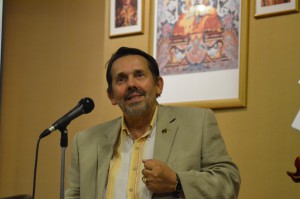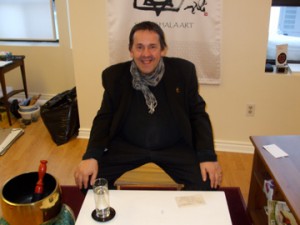Friday
Mandala ProjectsThe Path of Translating
Translating in the Ear Whispering Lineage
by Stéphane Bedard, Montreal, Quebec
When I started to read one of the Sakyong’s recent advanced texts, parts of the text were whispered to me in French. This was unusual. I read the whole book over several months and kept hearing this dharma in French. Then a year later I did a three month retreat and decided to read the text again in a practice atmosphere. Again, I would hear whole sections of the text in French. I decided this was a sign and that I had no choice but to translate a book which I had to admit frightened me somehow.
By the end of the retreat, in November 2012, I wrote to Sakyong Mipham Rinpoche and asked him to authorize me to translate the text into French. The Sakyong was on retreat then until Christmas. During the first week of January 2013, I received an email from David Brown, Executive Secretary to the Sakyong, who said that the Sakyong was very pleased to hear that I wanted to work on this book.
Because I was recently retired, I could now dedicate most of my time to this monumental task. I had to find a patron though because my income was considerably reduced as a newly retired practitioner. In the meantime, Shambhala Media agreed to publish the translation. I found patrons who were kind enough to support my work. And I started the translation without worrying about financing this journey.
Also, Suzanne Cote, from les traductions Nalanda, was pleased to revise my translation. I started to work on the book in January 2013. Most days, I would spend from six to eight hours, five or six days a week, on this 625 page book. I would interrupt this process only to prepare for teaching weekend programs or to go on various retreats.
I realized that one of the major difficulties was to sometimes decipher a text which was very lightly edited (that was confirmed by professional sangha English language editors). To some extent, I had to do some editing mentally. Also, the vast knowledge of Trungpa Rinpoche and of his son was often challenging to penetrate. In order to translate the work of realised beings one must let silence enter one’s heart.
It is also difficult to relate to teachings that are an “ego-squeeze” for the translator. For example, patience has never been my strongest point (my mother would say that when I was three years old). It seemed to me that the longest chapter of this book was entitled “Patience”. For some reason, I was often irritated while working on it, uninspired, or discouraged. I recall sending an email to David Brown asking him to “thank Rinpoche for giving me such a hard time.”
When I could not understand some parts of the text, I would contact English speaking dharma practitioners. Often I realised that the difficulty wasn’t related to the language, because the person couldn’t give me a precise answer. He or she understood the language but not the text meaning. I had the same experience several times with different people.
Fortunately, I found a shastri who could answer my questions. He had a very good understanding of dharma, but I knew that he also had an amazing literary culture and an excellent knowledge of the American language. He could always contextualise his explanations and enjoyed it. I learned a lot from him as well.
During the translation process which lasted 22 months, there were ups and downs. Sometimes I had the impression that I was not rendering justice to the book. I felt discouraged when I would read some corrections Suzanne would make. It is interesting to see the many details that a translator’s mind has to work with and how easy it is to lose mindfulness in the process. Although you think you were present while correcting your text, you realise you were out for lunch too often. Having your text revised by an experienced translator is very humbling. And to come back to humbleness is mandatory to do a sincere job.
While trying to put this precious book into French, I felt that one of the main criteria to take into account was devotion for the teacher. Devotion makes you check again and again, an expression, the precision of a term, the rhythm of a paragraph, a title, a coma. If you feel that he wouldn’t say it this way… it means that you’re trying to reach the reader’s heart, not just his intellect.
It is because you love the teachers that you can see them appearing in the text, pacifying you with a smile. Because you know that they give all they have to these teachings, you feel you have to do the same, otherwise you break samaya, and then you do not respect the teacher, the reader and yourself. In the translation process, when you do not let in your whole being, your whole life, which includes your emotional life, and your love for the teacher, the teachings and the readers, you translate concepts only.
You translate an “ism”, but you do not translate the “dharma”. There is a difference between “Buddhism” and “Buddhadharma”. This is probably why the Vidyadhara appreciated having his work translated by his own students. Because he knew that devotion was making us feel more paranoid and also more loving.
When a translator has the privilege to translate life transforming texts that will affect people’s journey for a long time, it is worth celebrating the joy of sharpening prajna by writing a text that will be a source of inspiration as a reading experience as well. Translating is a form of writing.
When my translation was finished, I read one page or two out loud. And I started to cry, so happy that this wisdom will be read some day by people who belong to a culture which taught me so much during my whole life. I knew that I was giving back by creating a bridge between two cultures. I felt that Trungpa Rinpoche was so kind and skillful when he asked me to be one of his French translators. And then, twenty years later, his son asked me the same question when it came time to translate Ruling your World. I recall that he was nervous when he posed the question, not knowing what my answer would be. Again, I was impressed by his warrior vulnerability and humbleness.
So, translating the teachings of my two gurus was very difficult and very easy at the same time. I felt protected and inspired by their love, their gentleness and their fearless wisdom. Today I feel humble, proud, happy and about to start a new book.
~~
Stéphane Bedard, founding member of Les Traductions Nalanda, has been translating the dharma from English into French since 1978. He has worked on the translation of more than twenty books written by Chogyam Trungpa Rinpoche, Sakyong Mipham Rinpoche, Acharya Pema Chodron and Acharya Jeremy Hayward.




















Mar 7, 2015
Reply
Thank you very much for sharing your path of translating the dharma with us
Mar 6, 2015
Reply
Comme un étudiant de français, je ai hâte de lire ta traduction. Il fera peut-être plus de sens en français qu’il fait en anglais!
Par ailleurs, au paragraphe antépénultième, je pense que vous devriez césure “life-transforming” à la place de la virgule que tu as. :-)
Mar 6, 2015
Reply
Wow, fascinating and beautiful
Mar 6, 2015
Reply
Dear Stephane, Well done – a great example of “Never Give Up” Love, Jan